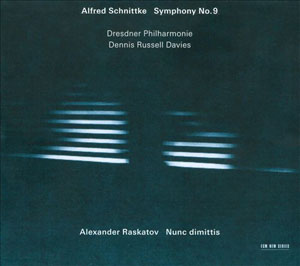 To Soviet composer Alfred Schnittke, music provided continuity, a connection with history and, in fact, to all of life. This is, perhaps, not so surprising: his musical education took place largely in post-War Vienna, and if anything typifies the life of Vienna, it is music. Nor is it surprising that, rather than Tchaikovsky, his main touchstones were Mozart and Schubert: there is a classical cast to his work, never imitative or blatant, but always there.
To Soviet composer Alfred Schnittke, music provided continuity, a connection with history and, in fact, to all of life. This is, perhaps, not so surprising: his musical education took place largely in post-War Vienna, and if anything typifies the life of Vienna, it is music. Nor is it surprising that, rather than Tchaikovsky, his main touchstones were Mozart and Schubert: there is a classical cast to his work, never imitative or blatant, but always there.
His first major Russian influence was Dmitri Shostakovich, but he soon flirted with the serial techniques of the Schoenbergian modernists, and then turned to a style that became known as “polystylism” — another way of saying eclectic. As his health began to fail in later years, his music became leaner, more stripped down, finally culminating in the spareness of the Symphony No. 9, his last work, unfinished at his death in 1998. The work was “finished” (which is to say, the nearly illegible manuscript — Schnittke had suffered a series of debilitating strokes and notated the score with his left hand — was cleaned up and rendered readable) by Alexander Raskatov, who also composed a Nunc dimittis as a tribute to Schnittke and a pendant to the symphony (although Raskatov is quite emphatic that in no way is it to be taken as a “fourth movement”).
The symphony establishes from the opening bars a particular ambience: the textures are, indeed, lean to the point of being stark, in spite of the forces employed (a full orchestra). The mood is not quite elegiac, but pensive and a little melancholy. There is a strong element of classical clarity here that underlies a series of images that combine into one overall picture while each maintains a distinct identity. One is tempted to speak of layers (which to my mind is a basic concept in Western music, and which I’ve found in everything from Brahms to Jefferson Airplane): they create contrasts that shape the movement, different voices sometimes acknowledging each other, sometimes not. The second movement continues the play of contrasts, but more forcefully: the mood shifts from pensive to a tension that almost reaches foreboding, punctuated by interludes that, while peaceful by comparison, never quite resolve that tension until a sudden, brief resolution. The third movement takes on a much more “normal” cast (normal for post-War music, anyway): what I call “twentieth-century angst” is there in full measure, along with strong evidence of atonalism and hints of a synthesis composed of many influences — one discerns traces of the scale of Shostakovich, Stravinsky’s neo-classicism, the edginess of some of Penderecki’s works, even a little bit of the sonorities of Tavener and Pärt. I’m not ascribing influences here, just noting commonalities, sometimes only revealed in a glimpse. The important part is the synthesis: this music does not belong to any of those I’ve mentioned, being, when all is said, its own creature. The resolution is haunting, almost ethereal, and as concise as that in the second movement.
Alexander Raskatov was selected by Schnittke’s widow Irina to salvage the autograph of the Ninth Symphony and to translate it into readable form. While working on that, he conceived the Nunc dimittis as a tribute to Schnittke. To be quite blunt, I find it more interesting than the main work on this disc. Perhaps that’s because it smacks more strongly of the music of Arvo Pärt, of which I am quite fond and with which I am much more familiar, although there is vanishingly small chance of mistaking the two. The vocals, while sometimes almost Straussian in their intensity (I’m speaking of the Strauss of Elektra and Salome, not Der Rosenkavalier) are admirably rendered by mezzo-soprano Elena Vassilieva, delivered not only with conviction but also with a certain degree of poignancy. The contrast with the almost liturgical feel of the choral parts by the Hilliard Ensemble is striking and provides much of the motive force of the music. (I might add that there are passages that remind me of nothing so much as the Carl Orff of Prometheus and Oedipus der Tyrann, but again, not exactly.) And the work does achieve a strong measure of dramatic tension — it has quite an edge to it.
For students and/or fans of “post-Soviet” music, or contemporary music in Europe overall, this ECM release is certainly worth investigating. Dennis Russell Davies and the Hilliard Ensemble are both synonymous with the best in contemporary music, and while I admittedly have a stronger response to Raskatov’s piece, the Schnittke Symphony No.9 is certainly substantial and provocative enough to engage the listener.
(ECM New Series, 2009) Elena Vassilieva, mezzo-soprano; The Hilliard Ensemble; Dresdner Philharmonie; Dennis Russell Davies, cond.
